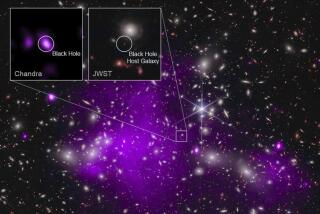Far-off galaxy is found
- Share via
Scientists have found the most distant space object yet observed, a galaxy born just 500 million years after the Big Bang.
The record-breaking discovery, reported Wednesday in the journal Nature, may aid exploration of a crucial period in the early history of the cosmos — a time when light from the earliest stars broke up the fog of hydrogen gas that shrouded the universe shortly after the Big Bang. That process created the “reionized” universe that exists today, scientists think.
“This is one of the most fundamental problems in astronomy — how the universe ionized,” said the study’s lead author, astronomer Matthew Lehnert of the Observatoire de Paris in France.
Lehnert said that though astronomers know reionization occurred, they don’t understand how, because they haven’t been able to observe the process underway. “That’s why [seeing this object] matters,” he said.
The Hubble Space Telescope first spotted the galaxy, named UDFy-38135539, after a camera that permitted clearer images of distant objects was installed on the telescope in May 2009. In October of that year, scientists began analyzing photos of a far-off portion of the sky known as the Hubble Ultra Deep Field.
They identified several faint “blobs” that might have been distant galaxies, Lehnert said. To confirm, astronomers needed to analyze the blobs’ light with a spectrograph — a device that could determine whether the light resembled that typically seen escaping far-off stars.
The team wasn’t sure the objects Hubble uncovered would be bright enough to analyze this way. Still, Lehnert secured 16 hours of time — considered generous — to observe UDFy-38135539 with the European Southern Observatory’s Very Large Telescope and the SINFONI spectrograph in Chile.
Crunching through the data over the course of two months, Lehnert and his colleagues determined with 99.99% certainty that the object’s light did appear to be coming from a distant galaxy, according to the Nature study.
The spectrograph also allowed scientists to pin down the galaxy’s so-called redshift, a measure of how fast the galaxy and Earth were moving away from each other due to the expansion of the universe. The larger the redshift, the more distant — and more ancient — the observation.
UDFy-38135539 had a redshift of 8.55 — meaning that light escaping it was emitted more than 13 billion years ago. The farthest galaxy previously detected had a redshift of 6.96. Its light started the trip toward Earth about 150 million years later than that of UDFy-38135539.
“It’s remarkable that in such a short time, well-developed galaxies already existed” in the universe, said Michele Trenti, an astrophysicist at the Center for Astrophysics and Space Astronomy of the University of Colorado in Boulder.
Trenti, who wrote an editorial accompanying the Nature paper, said it was likely there were more galaxies lurking at these great distances.
About one-tenth of the diameter of the Milky Way, and composed of approximately one billion stars, UDFy-38135539 wouldn’t emit enough light on its own to ionize the hydrogen gas that surrounded it, the Nature article reported. Unless there were more galaxies around it to help break down the hydrogen fog, the galaxy’s light probably could never have reached Earth.
Because UDFy-38135539’s glow is so faint, some scientists said they were skeptical of the results.
“The question of whether this is definitively the oldest is uncertain,” said Caltech astronomer Richard Ellis, who is coauthor of a forthcoming review in Nature about the reionization of the universe. “This is an ambitious and difficult measurement. People have been wrong before.”
But Ellis said the research remained “impressive,” and that it “demonstrates that it’s feasible to prove that these [galaxies] exist at long distances.” By viewing more distant galaxies, astronomers will figure out what happened in the universe’s early years, he said.
“We’re about to find out about one of the most interesting periods of the universe, about which not much is known,” he said. “It’s the last frontier, and we’re on the brink of observationally nailing it down.”






